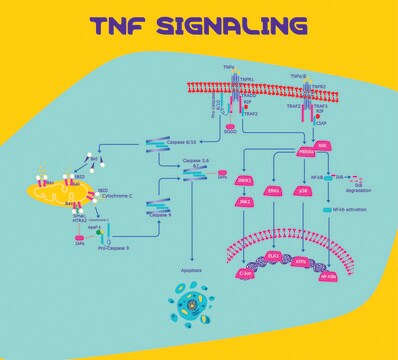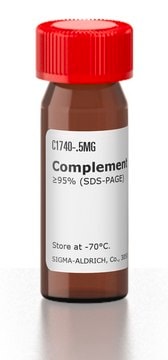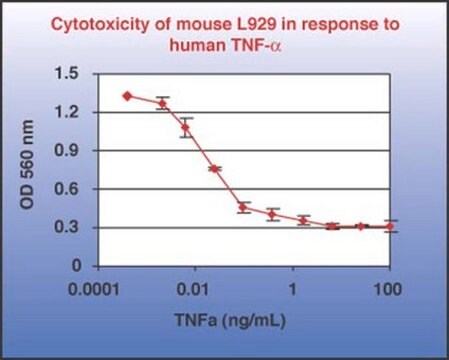I3901
IL-1α rat
≥97% (SDS-PAGE), recombinant, expressed in E. coli, lyophilized powder, suitable for cell culture
Synonym(e):
rIL-1α, IL-1α, Lymphocyte activating factor
About This Item
Empfohlene Produkte
product name
Interleukin-1α from rat, IL-1α, recombinant, expressed in E. coli, lyophilized powder, suitable for cell culture
Biologische Quelle
rat
Qualitätsniveau
Rekombinant
expressed in E. coli
Assay
≥97% (SDS-PAGE)
Form
lyophilized powder
Wirksamkeit
1-10 pg/mL ED50
Qualität
endotoxin tested
Mol-Gew.
~18 kDa
Verpackung
pkg of 5 μg
Methode(n)
cell culture | mammalian: suitable
Verunreinigungen
≤0.1 EU/μg
UniProt-Hinterlegungsnummer
Lagertemp.
−20°C
Angaben zum Gen
rat ... Il1a(24493)
Biochem./physiol. Wirkung
Physikalische Form
Hinweis zur Analyse
Lagerklassenschlüssel
11 - Combustible Solids
WGK
WGK 3
Flammpunkt (°F)
Not applicable
Flammpunkt (°C)
Not applicable
Persönliche Schutzausrüstung
Eyeshields, Gloves, type N95 (US)
Analysenzertifikate (COA)
Suchen Sie nach Analysenzertifikate (COA), indem Sie die Lot-/Chargennummer des Produkts eingeben. Lot- und Chargennummern sind auf dem Produktetikett hinter den Wörtern ‘Lot’ oder ‘Batch’ (Lot oder Charge) zu finden.
Besitzen Sie dieses Produkt bereits?
In der Dokumentenbibliothek finden Sie die Dokumentation zu den Produkten, die Sie kürzlich erworben haben.
Artikel
The Interleukins comprise a disparate group of cytokines and growth factors that are produced by and released from leukocytes. Interleukin-1β (1L-1β) is released primarily from stimulated macrophages and monocytes and plays a key role in inflammatory and immune responses and may induce anti-tumor immunity.
Unser Team von Wissenschaftlern verfügt über Erfahrung in allen Forschungsbereichen einschließlich Life Science, Materialwissenschaften, chemischer Synthese, Chromatographie, Analytik und vielen mehr..
Setzen Sie sich mit dem technischen Dienst in Verbindung.







